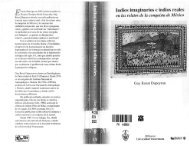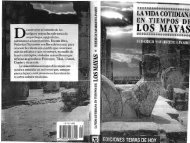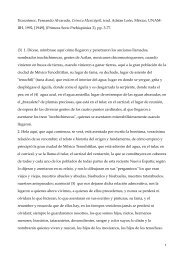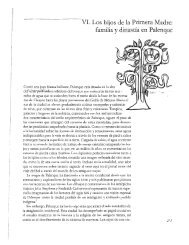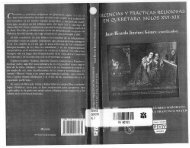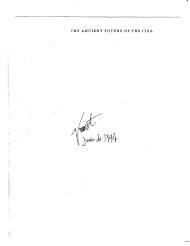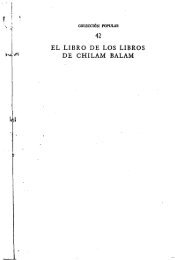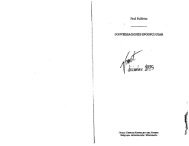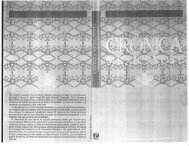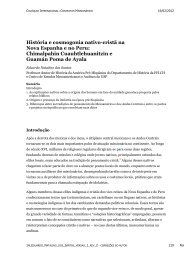- Page 1 and 2: HEAVEN BORN MERIDA AND ITS DESTINY
- Page 3 and 4: zA Havana '.BBEAN SEA 50 100 _l km.
- Page 5 and 6: Publication Data .script). English
- Page 7 and 8: CONTENTS Vil APPENDIX A. Concordanc
- Page 9 and 10: 209 U8 10 43 Acknowledgments .MyrrS
- Page 11 and 12: •SEy^*" Introduction Manuscripts
- Page 13 and 14: 3n of the lumayel original bishop o
- Page 15 and 16: primarily i neces- e, and it ed tha
- Page 17 and 18: i diseases, they al- id as Fa- ' ma
- Page 19 and 20: ire). And : of them the fold, hese
- Page 21 and 22: 7.0.0.0, clear evi- •K 0 the lear
- Page 23 and 24: d to some , thus dates. ladolid (V)
- Page 25 and 26: ed out cycles of ipeated. ogy, so l
- Page 27: nayel: Chable. hes the particule La
- Page 31 and 32: s. Insults as lying, 1 three-day) .
- Page 33 and 34: lave ended itual. The ;kin and with
- Page 35 and 36: DUth fellow) uch an Tacay int oncy
- Page 37 and 38: plate, burguar is must cerîty for
- Page 39 and 40: lave been hable, Hoi n "The Fall n
- Page 41 and 42: :ique and upied with un cererample,
- Page 43 and 44: inbow zzard •wer in rd h the day
- Page 45 and 46: nial— niais, beted next, teir ass
- Page 47 and 48: and there first age, d and provn of
- Page 49 and 50: id Izamal /ed again in iu hegemony
- Page 51 and 52: e menlies (Oc ot until : hurricane
- Page 53 and 54: in, and alct) their chapter i Long
- Page 55 and 56: ida in lapter 27) m end to îish ar
- Page 57: ;abo in Chahom îe south to order :
- Page 60 and 61: Q.: What is a man on a road? A.: Ti
- Page 62 and 63: 52 XI. Buluc ahau IX. Bolon ahau VI
- Page 64 and 65: 54 THE EIGHTH CENTURY T u menel ah
- Page 66 and 67: 56 (77) Bolon ahau hopci Xpnoil Uch
- Page 68 and 69: 58 THE EIGHTH CENTURY Uchci U payai
- Page 70 and 71: THE TENTH CENTURY 12 Ahau 3. The Th
- Page 72 and 73: 62 THE TENTH CENTURY Y can ahau Y c
- Page 74 and 75: 64 Ychil ah bolon ahau Katun (81) l
- Page 76 and 77: 6 6 THE FIFTEENTH CENTURY Top: Kak
- Page 78 and 79:
68 THE FIFTEENTH CENTURY T Ulom ah
- Page 80 and 81:
70 THE FIFTEENTH CENTURY Bin y anac
- Page 82 and 83:
72 THE SIXTEENTH CENTURY 9. The Ser
- Page 84 and 85:
74 THE SIXTEENTH CENTURY f U ti (ix
- Page 86 and 87:
76 Caan Y etel luum Mach utz ka u t
- Page 88 and 89:
78 THE SIXTEENTH CENTURY Kin Chil,
- Page 90 and 91:
8o THE SIXTEENTH CENTURY Uayom ch'i
- Page 92 and 93:
82 THE SIXTEENTH CENTURY Ca u katah
- Page 94 and 95:
84 Ca kuch ob: ti kal: Ti u kalah:
- Page 96 and 97:
86 Ca bin ob: kan a: Ca kuch ob: t
- Page 98 and 99:
88 THE SIXTEENTH CENTURY Ti mocon p
- Page 100 and 101:
90 Huh u uay ob Ca hok ob i: Tz'otz
- Page 102 and 103:
92 Act 9 Ca hop i: U hetz' luumob Y
- Page 104 and 105:
94 Accunte u xukil u luumob Ah accu
- Page 106 and 107:
96 THE SIXTEENTH CENTURY Ca tun cul
- Page 108 and 109:
98 Ti el i: C u than y ah kin ti ob
- Page 110 and 111:
IOO THE SIXTEENTH CENTURY Tz'a C ex
- Page 112 and 113:
I02 THE SIXTEENTH CENTURY 9: Hel e
- Page 114 and 115:
104 Yx chac ya Ybillo(b)* Yx chac*
- Page 116 and 117:
io6 THE SIXTEENTH CENTURY Ox paua h
- Page 118 and 119:
io8 THE SIXTEENTH CENTURY Ti ualaac
- Page 120 and 121:
no U chun cumtan tza THE SIXTEENTH
- Page 122 and 123:
I 12 In colobta T a chi e u kan ti
- Page 124 and 125:
114 Kin colah peten U hetz' katun O
- Page 126 and 127:
i 16 THE SIXTEENTH CENTURY T Yax Ch
- Page 128 and 129:
II8 THE SIXTEENTH CENTURY T u patá
- Page 130 and 131:
I20 Ca u hatz'ab* Ca tun tac ti cut
- Page 132 and 133:
122 THE SIXTEENTH CENTURY U nup tan
- Page 134 and 135:
124 THE SIXTEENTH CENTURY Oxlahun A
- Page 136 and 137:
126 THE SIXTEENTH CENTURY Hoil Caua
- Page 138 and 139:
128 THE SIXTEENTH CENTURY T 22. The
- Page 140 and 141:
I30 Bolon pis u lac Bolon pis u luc
- Page 142 and 143:
132 A4/7 i quinientos y quarenta y
- Page 144 and 145:
134 Na chi uc Ah kul koh Na chan mo
- Page 146 and 147:
136 THE SIXTEENTH CENTURY Uuc kal h
- Page 148 and 149:
138 THE SIXTEENTH CENTURY Ti u hop'
- Page 150 and 151:
THE SEVENTEENTH CENTURY 5 Ahau 26.
- Page 152 and 153:
142 THE SEVENTEENTH CENTURY Ba tab
- Page 154 and 155:
144 THE SEVENTEENTH CENTURY T u men
- Page 156 and 157:
146 THE SEVENTEENTH CENTURY Yx mact
- Page 158 and 159:
148 T u santo ok olal ob Y an u cux
- Page 160 and 161:
150 THE SEVENTEENTH CENTURY 3 Ahau
- Page 162 and 163:
152 THE SEVENTEENTH CENTURY 29. The
- Page 164 and 165:
154 THE SEVENTEENTH CENTURY CocAy,
- Page 166 and 167:
i56 THE SEVENTEENTH CENTURY Act 7 C
- Page 168 and 169:
158 THE SEVENTEENTH CENTURY (44) Ah
- Page 170 and 171:
160 THE SEVENTEENTH CENTURY Act 13
- Page 172 and 173:
IÓ2 THE SEVENTEENTH CENTURY Act 15
- Page 174 and 175:
164 THE SEVENTEENTH CENTURY Y utz'u
- Page 176 and 177:
i66 THE SEVENTEENTH CENTURY T u ban
- Page 178 and 179:
i68 THE SEVENTEENTH CENTURY T u xax
- Page 180 and 181:
I70 THE SEVENTEENTH CENTURY Ca bin
- Page 182 and 183:
172 THE SEVENTEENTH CENTURY Ti yx c
- Page 184 and 185:
174 THE SEVENTEENTH CENTURY Ca xic
- Page 186 and 187:
176 THE SEVENTEENTH CENTURY He ix c
- Page 188 and 189:
178 THE SEVENTEENTH CENTURY Seizure
- Page 190 and 191:
i8o THE SEVENTEENTH CENTURY Bin ix
- Page 192 and 193:
182 THE SEVENTEENTH CENTURY He x u
- Page 194 and 195:
i84 THE SEVENTEENTH CENTURY Lay pay
- Page 196 and 197:
186 THE SEVENTEENTH CENTURY Bay tun
- Page 198 and 199:
i88 Minan u kab i Ma a luksic y oil
- Page 200 and 201:
ico U kabil Cab Suyua Mehen e ca a
- Page 202 and 203:
192 THE SEVENTEENTH CENTURY Hun tul
- Page 204 and 205:
194 THE SEVENTEENTH CENTURY 31. Add
- Page 206 and 207:
196 THE SEVENTEENTH CENTURY Dios me
- Page 208 and 209:
198 THE SEVENTEENTH CENTURY U tuchi
- Page 210 and 211:
200 THE SEVENTEENTH CENTURY Y etel
- Page 212 and 213:
202 THE SEVENTEENTH CENTURY Tiy to
- Page 214 and 215:
204 THE SEVENTEENTH CENTURY Ca ix c
- Page 216 and 217:
2o6 THE SEVENTEENTH CENTURY He lay
- Page 218 and 219:
208 THE SEVENTEENTH CENTURY Can tza
- Page 220 and 221:
2IO THE SEVENTEENTH CENTURY Ti y ah
- Page 222 and 223:
2 12 THE SEVENTEENTH CENTURY Ohelta
- Page 224 and 225:
214 THE SEVENTEENTH CENTURY Tzolen
- Page 226 and 227:
2l6 THE SEVENTEENTH CENTURY Tali T
- Page 228 and 229:
2l8 Yax Chuen, lord of Valladolid (
- Page 230 and 231:
220 THE SEVENTEENTH CENTURY 10 Ahau
- Page 232 and 233:
222 THE SEVENTEENTH CENTURY Uay Tac
- Page 234 and 235:
THE EIGHTEENTH CENTURY 6 Ahau 4 Aha
- Page 236 and 237:
226 THE EIGHTEENTH CENTURY U cuenta
- Page 238 and 239:
228 Kan Y opol yk Oxil uah U uah ca
- Page 240 and 241:
230 O firmar* Ci jx u than Ca u kam
- Page 242 and 243:
232 De ¡a çipii na* Defentenote*
- Page 244 and 245:
234 T u ca tz'it katun He tun cu th
- Page 246 and 247:
236 THE EIGHTEENTH CENTURY U machma
- Page 248 and 249:
238 THE EIGHTEENTH CENTURY De mundo
- Page 250 and 251:
240 Çihil U can u yax batan op Hoc
- Page 252 and 253:
242 THE EIGHTEENTH CENTURY Lay ya t
- Page 254 and 255:
244 THE EIGHTEENTH CENTURY Ï Meqia
- Page 256 and 257:
246 THE EIGHTEENTH CENTURY La/ i ta
- Page 258 and 259:
248 THE EIGHTEENTH CENTURY Y Ulu 59
- Page 260 and 261:
250 THE EIGHTEENTH CENTURY Nachhen
- Page 262 and 263:
2$2 THE EIGHTEENTH CENTURY Ek t u n
- Page 264 and 265:
254 THE EIGHTEENTH CENTURY [note co
- Page 266 and 267:
256 THE NINETEENTH CENTURY Chiban k
- Page 268 and 269:
258 THE NINETEENTH CENTURY Ma tub u
- Page 270 and 271:
26o THE NINETEENTH CENTURY Ti tun u
- Page 272 and 273:
262 THE NINETEENTH CENTURY Ti jx y
- Page 274 and 275:
264 THE NINETEENTH CENTURY He tun c
- Page 276 and 277:
I. 3 2. 4 3. s 4. 5. 6. 7.« 8. 9.
- Page 278 and 279:
268 APPENDIX A c 26. 27. 28. 19." 3
- Page 280 and 281:
43. 143 Merida*144 177 \ •141 170
- Page 282 and 283:
272 Tz'itz'om Tun, 107 Tz'itz'on Tu
- Page 284 and 285:
274 Katun Ending Dates 8 Ahau 6 Aha
- Page 286 and 287:
276 Date Seat Mayapan Calendar 11 A
- Page 288 and 289:
278 BIBLIOGRAPHY BROTHERSTON, GORDO
- Page 290 and 291:
28o BIBLIOGRAPHY LAND A, DIEGO DE.
- Page 292 and 293:
282 BIBLIOGRAPHY THOMAS, CYRUS 1882
- Page 294 and 295:
284 goat; gopher; horse,- iguana; j
- Page 296:
286 capital, 502, 528, 1895, 1926,
- Page 299 and 300:
'ood; stones and ;Sj sun and moon;
- Page 301 and 302:
t, 585, 636, 641, J, 2258, 2260, 29
- Page 303 and 304:
ought and famine; ¡ney; meat; nect
- Page 305 and 306:
4387; fourfold, d, 2258, 2260, t, 3
- Page 307 and 308:
¿553; and gait, :, 804 r heart'),
- Page 309 and 310:
62-63; of wing of 2317,2359.2373, .
- Page 311 and 312:
ch, 4386; of land, 39, 5325, 6283
- Page 313 and 314:
'•urch; costquisitionj , ritual;
- Page 315 and 316:
c Jaguar, DRAMA, ,. 4096 i, 5586; s
- Page 317 and 318:
I, 6461, 6473, 6478¡ 33, 3137,3141
- Page 319:
s gourdroot, 3709; 1558, 1787,2328,



